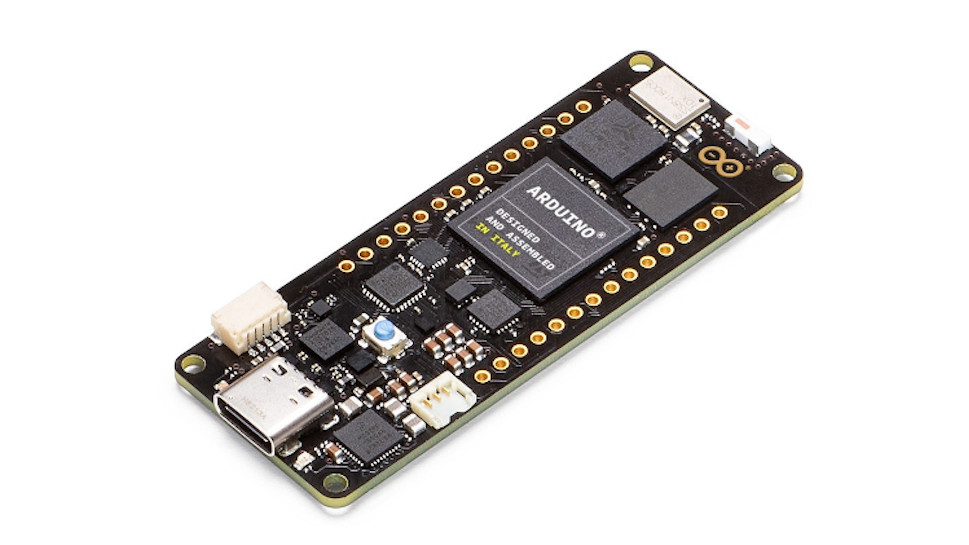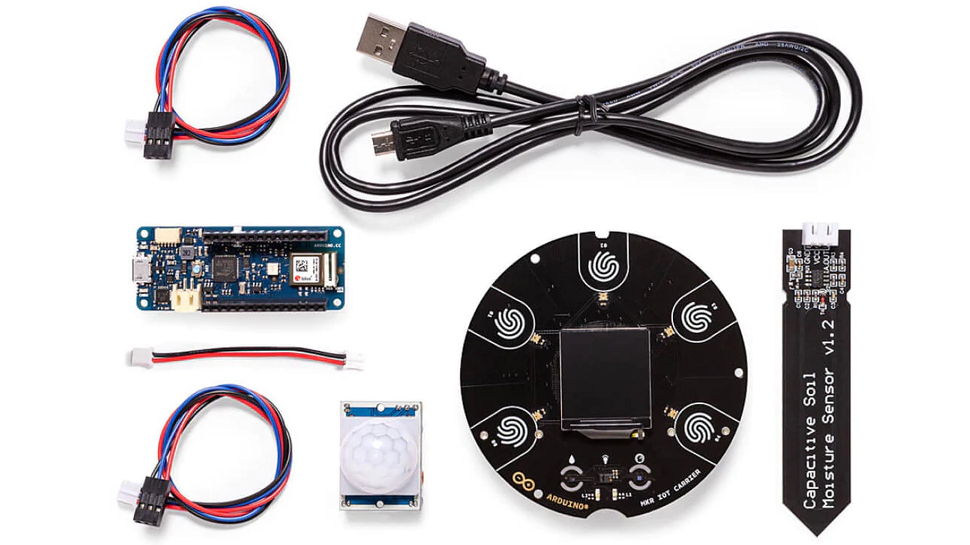Why Arduino has set a course towards uncharted waters
The CEO of Arduino talks us through the company's drive to bring its microcontrollers to production environments

When Arduino was first formed in 2005, the goal was to give students and hobbyists an easy way to prototype electronic devices.
Since then, however, the company's boards have featured inside increasingly complex systems and software has become a larger and larger part of its business.
Now, Arduino is making a drive towards the enterprise production environment, beyond the prototyping phase, and to find out more, we spoke to Fabio Violante, CEO at Arduino, who talked us through product strategy, his overarching vision for the company, and how it will invest its latest $32 million cash injection.
How would you describe Arduino to someone unfamiliar with the project?
Arduino was born at the Interaction Design Institute Ivrea as an easy-to-use tool for fast prototyping, aimed at students without a background in electronics and programming. The aim was, and still is, to make technology accessible and easy to use for everyone. We have always been focused on universal innovation, actively building a company that solves real problems and has a positive impact on the world.
Over the years, Arduino expanded to offer tools for education and professionals. In the past decade and a half, Arduino has been an integral part of STEM / STEAM programs all around the world. There is an entire generation who grew up learning about technology through our boards and software. Now, that generation is entering the workforce and they’re changing how engineering departments work. They want the flexibility, speed and ease they know from Arduino, and we are lining up new products and services to deliver that for them.
In what ways do Arduino boards differ from others on the market?
Arduino is known for microcontrollers, especially in real-time applications and control applications. Our ecosystem highlighted some very precise needs that would benefit from a slightly different approach, that takes the best of what’s available in the microcontroller and microprocessor worlds and combines them to provide real time control and intelligence.
For example, the Portenta X8 combines a dual core STMicroelectronics H7 Dual ARM® Cortex® M7/M4 and ARM Cortex M4 microcontroller and a Quad-core NXP® i.MX 8M Mini ARM® Cortex® -A53 core and ARM Cortex -M4 core microprocessor. The two parts of the device can talk to each other through a multi communication mechanism, thus allowing the user to take advantage of both.
This enables people to develop applications that deal with the most sophisticated aspects of the cloud whilst also keeping the real-time aspect. This is particularly important in the enterprise where there is a high level of knowledge in developing Linux applications, especially as containers, whilst on the other side there is also a need for deterministic and fast control. Robotics, AGV, multiprotocol gateways, and smart kiosks are among the target applications.
The latest devices are designed having a production and industrial production use case in mind. This means the microprocessor and all the components on the board have a higher temperature range to deal with the harsh environments. Combined with the security aspect (the Portenta X8 is PSA certification by Arm) these features put the Arduino Pro range into a different class of devices for industrial usage. They are products that can easily be put into a machine or as a product to retrofit a process and send data to the cloud without having to also install additional heaters and/or cooling devices.

The company is perhaps most famous for its hardware, but tell us about the software side of things
Arduino has evolved into a complete platform providing hardware, firmware, software, cloud services and content. To achieve the aim of making technology accessible and easy to use for everyone, in the enterprise our approach to software and cloud services is an essential component.
Arduino provides the most complex libraries to solve enterprise problems (e.g. connecting field bus like mod bus). We are also developing partnerships related to AI applications to make it possible to do image recognition or signal processing on a microcontroller without the developer having to know all the details about how the algorithm works.
Why is the open source model the right one for Arduino?
Open source is fundamental to accelerate innovation, leveraging the scale and the expertise of the Arduino user community, which contributes new features, bug fixes and collaborative review of code changes.
It also provides a key benefit to professional developers by enabling faster adoption of the technology thanks to the additional flexibility and reduction of the lock-in risks.
Our revenue model related to software is more sophisticated compared to the traditional closed-source models based on selling licenses regardless of the usage scenario. We base our technology stack on OSI-approved software licenses that allow the code to be used, studied and modified by anyone; at the same time we offer dual licensing options for enterprises and professionals who need even more control.
How will Arduino seek to deploy the funds generated in its latest funding round?
The funds will be primarily devoted to R&D, as we develop more sophisticated technology, transforming into the Arduino platform with hardware, firmware, cloud services and content.
A key aim is to reduce friction, both for generation Z by providing them with a familiar environment as they enter the embedded and AIoT world, and for engineers in general by reducing the amount of redundancy. Arduino provides engineers with the tools to avoid the need to rewrite or repeat tasks and coding, thus leaving them free to focus upon the end application. These will be especially noticeable through the Arduino Cloud that will be easier and faster than ever before.

Tell us about the push into enterprise. What's the strategy there?
Arduino has millions of followers and passionate users around the globe. When we analyzed the use cases, we found that hundreds of thousands of companies were using Arduino for rapid prototyping of complex applications. This applied to companies of all sizes, from major corporations like Apple and CocaCola to your typical SMEs. At the same time, in many cases Arduino was being used in production applications, such as developing test equipment or mechatronics applications.
Thus, the strategy is to provide enterprises with a full stack from HW, FW, libraries and accessories to enable scaling from prototype to production seamlessly. In companies where there is little or no internal R&D capabilities, Arduino provides the tools acting as the blocks for them to build more sophisticated applications without having to design a custom board. We help them approach IoT and connected products without the need to invest in design services or hire design engineers, enabling them to focus on the applications they are designing.
Is there still a place for the hobbyist in Arduino's new vision?
Yes, Arduino and our Series B investors are committed to continuing the great support for the Arduino community and its global ecosystem. We have recently strengthened the team devoted to makers to ensure we will continue to enhance the innovative tools for our maker Audience and engage with them.
For example, at the beginning of June we announced the launch of the Arduino User Groups program to officially recognize and provide our support to those groups and clubs who meet together to learn and share their experience of Arduino. With 169 applications to date from all around the globe, we’re really pleased to see the passion from hobbyists for Arduino.
Furthermore, we have many new products in the pipeline for the end of 2022/early 2023 from enhancing some of the classic Arduino boards to totally new concepts and kits. Our new vision is not a change of course from our core mission of democratizing the most advanced technologies, but a strong extension of it towards the professional market, in addition to the traditional market of makers and creators.
What will the continued rise of IoT and IIoT mean for the Arduino project?
The continued rise of IoT and IIoT provides an exciting opportunity for Arduino, not only with the microcontrollers and microprocessor, but also with the importance of sensors. Arduino provides devices that bring to users high-end sensing capabilities with intelligence at a very accessible price point with a tiny form factor and low energy consumption. The ability to sense and process many different types of data on the edge increases autonomy and reduces latency and power consumption, offers more privacy and requires less bandwidth. For example, the Arduino Nicla Sense ME features the latest sensors from Bosch Sensortec combined with a microcontroller, so you can run tiny machine learning algorithms locally to detect patterns on the device and then trigger an action in the cloud, opening up a whole new range of applications leveraging on-sensor fusion.
Arduino also sees a great potential in machine and system control: the introduction of competitive secure connectivity features is now possible together with more standard fieldbus and I/O interfaces, opening the opportunity for PLC disruption in many application fields. Compact machinery and ancillary production equipment can benefit from Arduino products, like Portenta Machine Control, and from an outstanding user experience, mixing Arduino with more traditional PLC programming languages. All in keeping with Arduino’s aim to make complex technology accessible and simple to use for everyone regardless of ability level.
Are you a pro? Subscribe to our newsletter
Sign up to the TechRadar Pro newsletter to get all the top news, opinion, features and guidance your business needs to succeed!